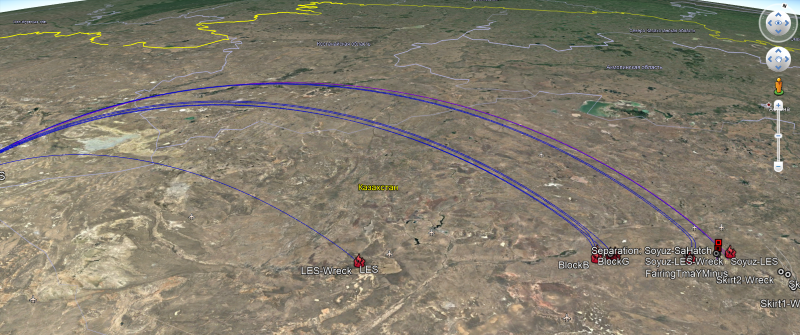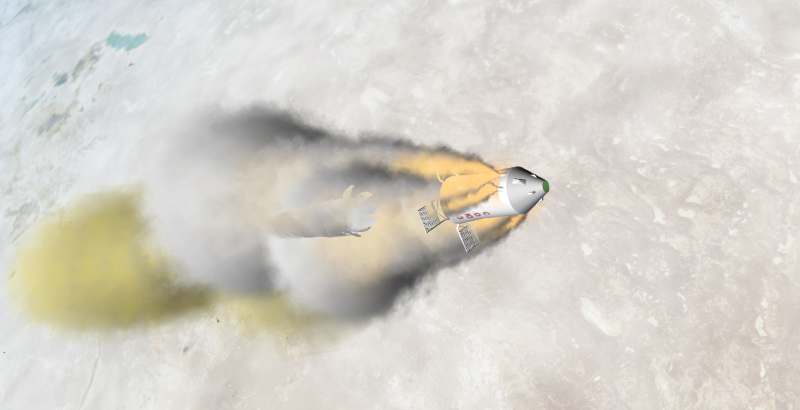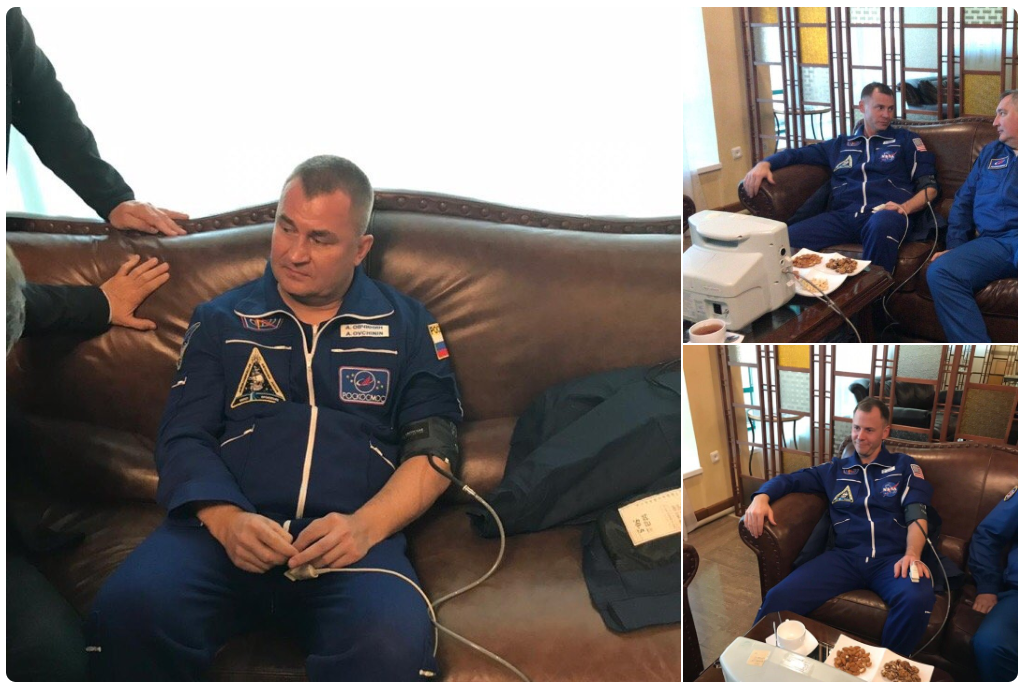Emergency launch of Soyuz MS-10 (crew rescued, broadcast over)
At the end of the second minute of the Soyuz-FG launch vehicle launch with the Soyuz MS-10 spacecraft, an accident occurred. The ship separated from the rocket and made a soft landing on the territory of Kazakhstan. The astronauts, Alexey Ovchinin and Tyler "Nick" Haig, are alive and well. Under the cut chronicle of events.

NASA-TV (with English dubbing)
Now the ship is descending in the same way as a regular landing would have gone. Despite a certain nervousness, the technique should work as in normal flight. It is necessary to determine the landing site and send a search and rescue squad there. NASA-TV shows Houston, most likely turned off the broadcast.
')
The last time such a situation was in 1975 at the Soyuz-18-1 . Then everything turned out well.
Search and rescue services will reach the landing site in about an hour and a half. We are waiting for 13:30 MSK.
12:12 Moscow time. While there are no updates, we restore from memory a picture of what happened. The flight went regularly for the first two minutes. Four blocks of the first stage were successfully separated, the emergency rescue system was separated (Gazeta.ru already wrote that it worked, this is not so). Separated head fairing. Then the Morozian “AN” signal went off - a carrier crash. Someone managed to notice that the astronauts noticeably shook.
12:20 Moscow time, the search and rescue teams have established contact with the astronauts. Alexey Ovchinin and Tyler "Nick" Haig are alive and feeling good .
12:38 So far there is no news, here is the approximate flight path of the ship. Landing took place in Kazakhstan.

12:47 If you unwind the NASA-TV broadcast to the accident area, you can see the premature separation of one first-stage unit (right-bottom)

In such conditions, the control system could not support a controlled flight. The physics of the separation of steps on the Soyuz is such that in the event of the disappearance of thrust on one of the blocks, it is simply separated. Hence the obvious version of the cause of the accident - the thrust on one of the first-stage units disappeared. The reason for this is already established by the commission.
12:55 Interestingly, the question of how the rescue system is triggered remains open. From the video frames, it seems that the second stage was greatly driven by the block (this is normal due to the asymmetry of the thrust). Most likely, the slip engines on the head fairing (if it did not have time to separate) worked. This explains the overload 6 "same", which felt the astronauts. On the other hand, in the broadcast you can hear "there is a reset of GO (head fairing), there is a reset of the SAS control system (of the propulsion system of the emergency rescue system)." But since the broadcast is read out on a piece of paper, it may not correspond to real events. We learn by the second what was the result of the commission’s work.
But this could look like the separation of a ship under GO on engines of escape.

Video of the accident with the broadcast Roscosmos
13:16 Search and rescue teams reached the descent vehicle and evacuated the astronauts.
Frames crash

14:06 TASS reports, on the one hand, that the crew’s health is “not very good,” and then that “special hospitalization is not required.” While the information is based on anonymous "sources in the industry" (again, alas), it is worth questioning it. NASA-TV reports that the crew is already in the helicopter, and they repeat that the condition of the astronauts is good.
14:27 On NASA-TV, the session with ISS was replayed. Mentioned overload, 6.7 "same." Obviously, she was already at the descent, when the ship braked on all the more dense layers of the atmosphere. The altitude at the time of the accident was above 40 km. If the accident had happened later, when the ship was already accelerating stronger, then the overload would be more, like that of the Soyuz-18-1
Some statistics - before this accident, the reliability of the Soyuz-FG launch vehicle was 100% - 64 successful launches since 2001. It is also the first accident at the launch site of the manned cosmonautics of Russia - the previous one was in 1975, during the Soviet era. Other incidents can be read in a series of “almost-happened cosmic catastrophes” ( one , two , three ).
Photos of cosmonauts appeared on the Roscosmos twitter, apparently after landing.

Meeting astronauts at the airport, broadcast RT
Commentary: The accident at the site of the first stage (it seems obvious from the video, but we do not have telemetry and other data) was not long enough. I remember the accident when the biological and physical satellite Foton-M1 was launched in 2002, when the rocket fell just a few tens of seconds after the launch. For obvious reasons, the need to find the cause and eliminate it means a break in flights for at least several months. Soyuz MS-09 has been in orbit since June, and other ships cannot be quickly launched to the ISS - Dragon V2 and Starliner are not yet ready. The orbiting of three astronauts and astronauts who are there now can be extended, but not indefinitely. Perhaps for the first time since 2000, the ISS will fly for some time without a crew. Also, at the Soyuz MS-10, the third place was occupied by the cargo container, because the first astronaut of the United Arab Emirates, who was to go on the next ship, was going to return on it. These plans will definitely be postponed for at least six months.
Conclusion: Accidents were, are and will occur. The main thing is that the astronauts are alive and well. The ship "Soyuz" not for the first time showed its reliability and ability to save the crew.

NASA-TV (with English dubbing)
Now the ship is descending in the same way as a regular landing would have gone. Despite a certain nervousness, the technique should work as in normal flight. It is necessary to determine the landing site and send a search and rescue squad there. NASA-TV shows Houston, most likely turned off the broadcast.
')
The last time such a situation was in 1975 at the Soyuz-18-1 . Then everything turned out well.
Search and rescue services will reach the landing site in about an hour and a half. We are waiting for 13:30 MSK.
12:12 Moscow time. While there are no updates, we restore from memory a picture of what happened. The flight went regularly for the first two minutes. Four blocks of the first stage were successfully separated, the emergency rescue system was separated (Gazeta.ru already wrote that it worked, this is not so). Separated head fairing. Then the Morozian “AN” signal went off - a carrier crash. Someone managed to notice that the astronauts noticeably shook.
12:20 Moscow time, the search and rescue teams have established contact with the astronauts. Alexey Ovchinin and Tyler "Nick" Haig are alive and feeling good .
12:38 So far there is no news, here is the approximate flight path of the ship. Landing took place in Kazakhstan.

12:47 If you unwind the NASA-TV broadcast to the accident area, you can see the premature separation of one first-stage unit (right-bottom)

In such conditions, the control system could not support a controlled flight. The physics of the separation of steps on the Soyuz is such that in the event of the disappearance of thrust on one of the blocks, it is simply separated. Hence the obvious version of the cause of the accident - the thrust on one of the first-stage units disappeared. The reason for this is already established by the commission.
12:55 Interestingly, the question of how the rescue system is triggered remains open. From the video frames, it seems that the second stage was greatly driven by the block (this is normal due to the asymmetry of the thrust). Most likely, the slip engines on the head fairing (if it did not have time to separate) worked. This explains the overload 6 "same", which felt the astronauts. On the other hand, in the broadcast you can hear "there is a reset of GO (head fairing), there is a reset of the SAS control system (of the propulsion system of the emergency rescue system)." But since the broadcast is read out on a piece of paper, it may not correspond to real events. We learn by the second what was the result of the commission’s work.
But this could look like the separation of a ship under GO on engines of escape.

Video of the accident with the broadcast Roscosmos
13:16 Search and rescue teams reached the descent vehicle and evacuated the astronauts.
Frames crash

14:06 TASS reports, on the one hand, that the crew’s health is “not very good,” and then that “special hospitalization is not required.” While the information is based on anonymous "sources in the industry" (again, alas), it is worth questioning it. NASA-TV reports that the crew is already in the helicopter, and they repeat that the condition of the astronauts is good.
14:27 On NASA-TV, the session with ISS was replayed. Mentioned overload, 6.7 "same." Obviously, she was already at the descent, when the ship braked on all the more dense layers of the atmosphere. The altitude at the time of the accident was above 40 km. If the accident had happened later, when the ship was already accelerating stronger, then the overload would be more, like that of the Soyuz-18-1
Some statistics - before this accident, the reliability of the Soyuz-FG launch vehicle was 100% - 64 successful launches since 2001. It is also the first accident at the launch site of the manned cosmonautics of Russia - the previous one was in 1975, during the Soviet era. Other incidents can be read in a series of “almost-happened cosmic catastrophes” ( one , two , three ).
Photos of cosmonauts appeared on the Roscosmos twitter, apparently after landing.

Meeting astronauts at the airport, broadcast RT
Commentary: The accident at the site of the first stage (it seems obvious from the video, but we do not have telemetry and other data) was not long enough. I remember the accident when the biological and physical satellite Foton-M1 was launched in 2002, when the rocket fell just a few tens of seconds after the launch. For obvious reasons, the need to find the cause and eliminate it means a break in flights for at least several months. Soyuz MS-09 has been in orbit since June, and other ships cannot be quickly launched to the ISS - Dragon V2 and Starliner are not yet ready. The orbiting of three astronauts and astronauts who are there now can be extended, but not indefinitely. Perhaps for the first time since 2000, the ISS will fly for some time without a crew. Also, at the Soyuz MS-10, the third place was occupied by the cargo container, because the first astronaut of the United Arab Emirates, who was to go on the next ship, was going to return on it. These plans will definitely be postponed for at least six months.
Conclusion: Accidents were, are and will occur. The main thing is that the astronauts are alive and well. The ship "Soyuz" not for the first time showed its reliability and ability to save the crew.
Source: https://habr.com/ru/post/426039/
All Articles